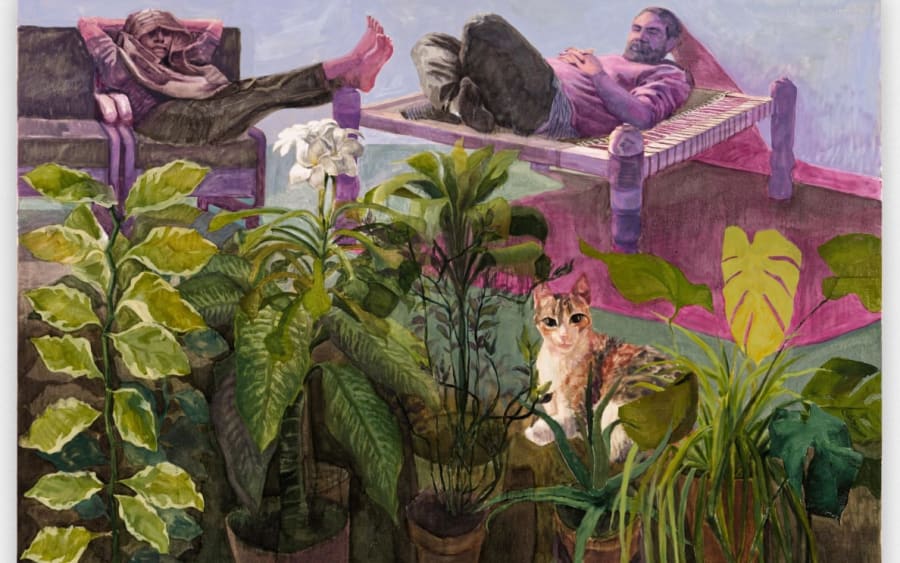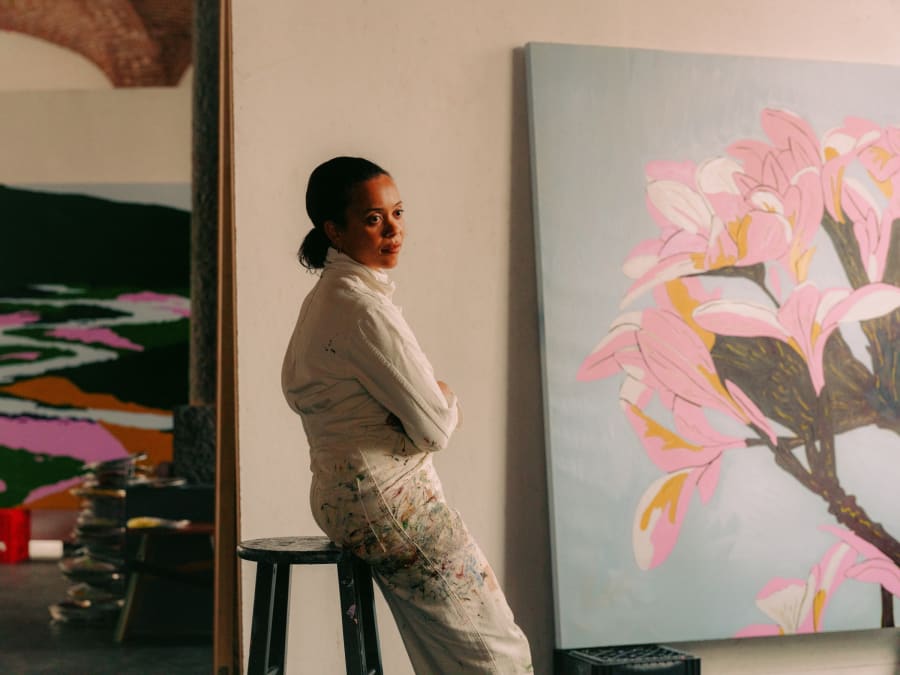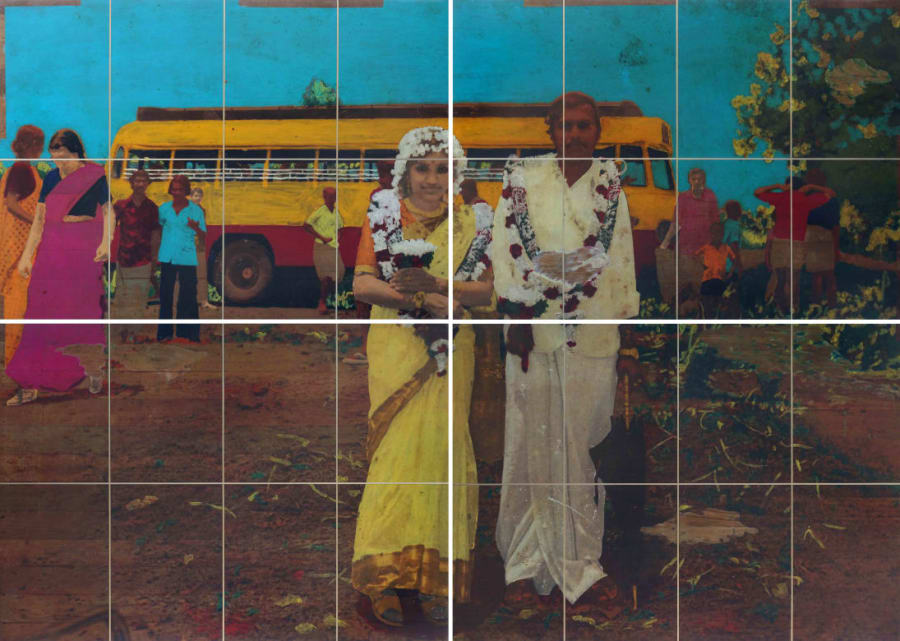In many ways, the practice of South Korean artist Suki Seokyeong Kang defies categorization. Her abstract sculptural works incorporate machine-made and hand-shaped metal structures, flexible yet sturdy textiles, strands of multicolored thread and assorted pieces of wood, empty picture frames, and tall stacks of painted canvases. An experimental ambience pervades Kang’s bright, second-floor studio in Seoul. This dense, well-organized space reflects her engagement with the materials and conceptual currents that constitute her oeuvre. ‘Everything passes through and touches my hands,’ she says, underscoring the striking tactility of her sculptures.
The minimal approach Kang adopts to create many of her sculptural series – including ‘Jeong’ (2014–ongoing), ‘Rove and Round’ (2016–ongoing), and ‘Mat’ (2017–ongoing) – can be traced to an unlikely source: a fifteenth-century Korean musical notation system known as jeongganbo, which uses rectangular grids to record pitch and rhythm. But, beyond the sounds of traditional Korean music and its corresponding visualization through abstract symbols laid out on paper, Kang’s interest is in translating sensory experience into physical form – and the conceptual possibilities this opens up.
Surprisingly, Kang’s background is not in sculpture at all, but rather in the East Asian tradition of ink painting. She devoted years to studying this time-honored discipline at Ewha Womans University in Seoul, where her artistic inquiry into notions of space and substance began to develop. By her own account, however, her art-school experience was a chaotic period of deep questioning as she struggled to apply her understanding of tradition to contemporary artmaking. ‘Most of my friends were making really beautiful landscape paintings,’ she explains. ‘I always thought, “Why do I have to draw the mountain? Can I draw that kind of form using paper rather than depicting a mountain?”’ These questions led to a revelation that would unfold a new trajectory in her artistic journey: ‘Finally, I told my professor, “This paper itself is a mountain.”’
The shift arose from Kang’s growing interest in the nonrepresentative elements of traditional ink painting that appeared in the works of artists such as Jeong Seon (1676–1759), Sim Sa-jeong (1707–1769), and Yi Jae-gwan (1783–1837). These and other literati painters from Korea’s Joseon dynasty were masters of si-seo-hwa – literally, ‘poetry-calligraphy-painting’ – in which depictions of landscape are augmented by several lines of poetry or other written commentary, executed in calligraphy directly onto the paper surface. By including text alongside imagery, si-seo-hwa works counteract the illusionistic sensibility of the painted image and reiterate the flatness of the picture plane. Rather than merely reproducing visual sensation, they channel the artist’s thoughts. For Kang, these text-based annotations suggested a distinct but equivalent mode of sharing the perceptions and feelings that the landscape inspires in her – an embodied experience of layered subjectivity.
The multidimensionality of si-seo-hwa is ever-present in the sculptures that Kang has made for the past 15 years. This is evident even in her series ‘Grandmother Tower’ (2011–ongoing), which was among her first experiments in producing freestanding structures installed directly on the gallery floor. Consisting of cylindrical industrial dish carriers whose metal armatures are wrapped in colored threads and stacked into vertical arrangements, they are among Kang’s most recognizable works. The precarious balance of these sculptures resembles the hunched-over posture of her own grandmother toward the end of her life, yet Kang does not consider the ‘Grandmother Tower’ sculptures solely as homages to her family matriarch. They are also landscapes.
‘I was thinking about myself and my family – my grandmother, my mother – about people and about individuality from a very close distance,’ she reflects. As Kang sought to encapsulate the life force of her late grandmother in sculptural form, she also opened herself to a heightened awareness of temporality and the emotional response it elicited. Just as the most compelling landscape paintings reveal something ineffable about a scene, so too do Kang’s sculptures in their capacity to visualize fragments of narratives that synthesize with the viewer’s experience. The expressive potential of an accurate representation – akin to a depiction of a mountain that faithfully reproduces its characteristics – has never been particularly interesting to Kang. Instead, she creates layers of meaning.
In recent years, Kang has reoriented toward what she describes as a more ‘universal’ or ‘public’ conception of individuals as they relate to society. In 2022, she unveiled her first large-scale outdoor commission, ‘Here We Hear’, in Doha, Qatar. Monumental in scale and fabricated from pink marble, matte silver-coated stainless steel and rust-colored Corten steel, this sculptural ensemble is assembled from numerous elements that evince notions of community and connection. The point of departure for this project was Kang’s fascination with Qatar’s traditional Bedouin tent structures and their associations with family gatherings, reflected in the semi-enclosed circular arrangement of sculptural forms. ‘Here We Hear’ was envisioned as ‘a form of shelter – more like a house or other architecture – that can invisibly protect and allow for greater individuality,’ says Kang, inviting people to congregate and listen to one another’s stories.
These ideas also inspired Kang’s 2023 mid-career survey, ‘Willow Drum Oriole’, held at the Leeum Museum of Art in Seoul. The exhibition was developed over the course of several years and included more than 130 works of sculpture, textile, and painting. A watershed in Kang’s practice, the show introduced an expanded sensibility of bodies converging across histories and contexts, suggesting a social landscape. Its organic and amorphous forms filled Leeum’s galleries and spilled out into the lobby.
The amebic exhibition layout added yet another degree of personal subjectivity by conflating Kang’s artistic development with the spatial logic of the museum’s permanent collection. ‘When I was student,’ she recalls, ‘I went to Leeum quite often because they have two different collections – traditional and contemporary,’ each displayed in separate buildings that connect through the central lobby. When planning the exhibition, she says, ‘I was thinking about “time,” as an artist who started out studying traditional painting, and how I might share the timeline of what I studied in a contemporary way.’ The meeting space halfway between the museum’s traditional and contemporary holdings proved to be the perfect prologue to the show, allowing Kang to ‘compress the history and the present within Leeum’s architecture.’
Perhaps it was the memory of art school that triggered a reconsideration of Kang’s old koan – the one about the mountain. Among the numerous bodies of work exhibited in ‘Willow Drum Oriole’ were roughly three dozen sculptures, each consisting of little more than a line in space tracing a thin, asymmetrical arch like the undulating topographies found in si-seo-hwa. The debut of her series ‘Mountain’ (2020–ongoing) at Leeum seemed to resolve the questions of her student days, and it was fitting that they were featured so prominently in her solo exhibition held at the same institution where she originally encountered those masterpieces of ink painting that altered the course of her career so many years ago.
‘When I studied traditional Korean painting, it was hard for my youthful mind to adapt to that very old philosophy,’ Kang confesses. These days, however, she sees things differently. ‘Usually, there are a lot of mountains, but it’s not about the real “mountain”. There are a lot of temporalities and seasons, and all kinds of different materials are just mixed together.’ Today, Kang is back at her alma mater, now teaching as a professor in the same department where she studied 25 years ago. And the mountain? It’s the focus of her latest solo exhibition, ‘Mountain—Hour—Face’ at MCA Denver, where her works unfold new interpretations of landscape in dialogue with the surrounding environment, connecting the mountains in her mind with the majestic peaks that frame the Mile High City.
Suki Seokyeong Kang is represented by Tina Kim Gallery (New York) and Kukje Gallery (Seoul and Busan).
‘Mountain—Hour—Face’ runs at MCA Denver until May 4, 2025.
Andy St. Louis is an art critic and curator specializing in Korean art and visual culture. In 2024, he published Future Present: Contemporary Korean Art, a landmark survey of the millennial generation of Korean artists.
Top image: Installation view of Suki Seokyeong Kang at Tina Kim Gallery, New York, 2024. Image courtesy of the artist and Tina Kim Gallery. Photo by Hyunjung Rhee.
Published on February 21, 2025.


